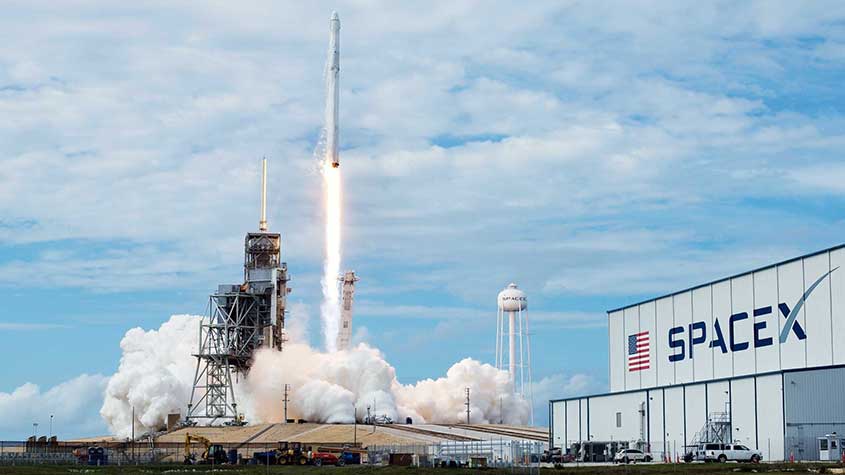In a step that commercialises space travel, US private space firm SpaceX on Friday announced that it will send the first private passenger to Moon and will reveal his identity on Monday.
The tourist will fly in the Big Falcon Rocket (BFR) being designed to carry people into deep space, the Elon Musk led company said in a tweet.
"SpaceX has signed the world's first private passenger to fly around the Moon aboard our BFR launch vehicle -- an important step toward enabling access for everyday people who dream of travelling to space.
"Find out who's flying and why on Monday, September 17," the tweet said.
The BFR will be used to explore Mars -- a goal that Musk hopes to accomplish by 2022.
"SpaceX will probably build 30 to 40 rocket cores for 300 missions over five years. Then the BFR takes over and Falcon retires. Goal of BFR is to enable anyone to move to Moon, Mars and eventually outer planets," Musk had said in May.
Only 24 humans have been to the Moon so far, and no one has visited since the 1972 Apollo mission.
However, it was not clear whether the BFR tourism mission has any link to an announcement SpaceX made in February 2017, the CNN reported.
At that time, SpaceX said two people signed a deal with SpaceX to make a trip around the moon aboard a Falcon Heavy rocket. SpaceX was tight-lipped about the financial terms of the deal and the identity of the individuals.
In February, SpaceX debuted the long-awaited Falcon Heavy, which became the world's most powerful operational launch vehicle, the report said.
But during a Falcon Heavy press conference earlier this year, Musk told reporters that, for the time being, SpaceX had no plans to certify the Falcon Heavy for human spaceflight.
Instead, Musk said, SpaceX would turn its focus to developing the BFR, which he deemed a better option for tourism missions.
In December 2017, US President Donald Trump also issued a directive to "lead an innovative space exploration programme to send American astronauts back to the moon, and eventually Mars".
The new heavy-lift rocket that NASA is developing for deep-space missions -- known as the Space Launch System -- could serve as a core component of a moon trip.


Google sacks 28 employees involved in protests over Israel govt contract
Tech giant Google has laid off 28 employees who were involved in sit-in protests at its offices over a Google contract with the Israeli government.
'Made in India' tech like DPI can be transformative for the world: Bill Gates
Microsoft Co-founder and billionaire philanthropist Bill Gates on Saturday said that technologies like digital public infrastructure (DPI) that are created in India can be transformative for the world.
India is the next big playground for AI: Samsung VC, CEO JH Han
Samsung Electronics Vice Chairman, CEO and Head of the Device eXperience (DX) Division Jaong-Hee (JH) Han, who visited Samsung BKC at Jio World Plaza, Mumbai for the first time since the store's opening, said on Friday that India is the next big playground for artificial intelligence (AI).
ISRO's step towards realising Indian space shuttle 'Pushpak'
India progressed further in its attempt to realise a reusable launch vehicle (RLV)/ rocket named 'Pushpak' by successfully test landing RLV LEX-2 on Friday at the Aeronautical Test Range (ATR) in Karnataka's Chitradurga.
AI will be smarter than any single human by next year: Musk
Elon Musk who is currently locked in a battle with ChatGPT maker OpenAI said on Wednesday that artificial intelligence (AI) will probably be smarter than any single human by next year.
NASA’s Crew 7 targets March 12 to return to Earth
NASA’s Crew 7 astronauts onboard the International Space Station (ISS) are preparing to return to Earth, after a six-month stay in the orbiting lab, the US space agency has said.
Meta suffers mega outage as FB, Instagram, Messenger stop working for millions
In one of the worst outages for Meta in years, its entire family of apps -- Facebook, Instagram, Messenger and Threads -- went down for millions across the globe, including in India, as users were thrown out from their accounts.
Narendra Modi first PM to visit ISRO’s VSSC in 4 decades, meets Gaganyaan astronauts
Narendra Modi on Tuesday became the first Prime Minister to visit the Indian Space Research Organisation’s (ISRO) Vikram Sarabhai Space Centre (VSSC) in four decades, where he met the four astronaut-designates of India's Gaganyaan Mission